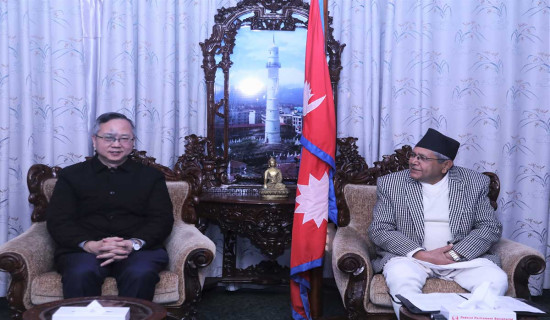- Sunday, 21 December 2025
Dashain Between Generations
Dashain festival falls on the month of Asoj when autumn season is at its height. The air feels balmy as the heat and humidity of the monsoon season subsides. The sky is clear blue with occasional fluffy clouds and minimal precipitation. It is during such pleasant weather that the festival of Dashain arrives with much fanfare among Nepalis.
Most grown-up Nepalis have a fond memory of Dashain from their childhood. They remember wearing brand new clothes, receiving and giving tikas (a mixture of vermillion, yogurt and rice), enjoying non-vegetarian foods and sweet dishes while relaxing at home from school break. They might also remember the happy faces around them as family, friends and relatives gathered together in a festive and jovial mood. The holidays then meant play and rest time. Now the young generations too get to experience Dashain but in a rather different manner.
In a break from schools, they enjoy unlimited screen time even as parents urge them to go outside and enjoy the fresh air. Use of smartphones takes a major portion of children’s holidays these days. It calls for a moderate use of screens and fun and engaging activities that don’t include smart devices. Additionally, young children today might not be quite excited about festive celebrations during Dashain as their parents used to be.
Elders have the responsibility of passing down age-old traditions to young children who absorb their surrounding environment quite avidly like a sponge. Particularly those living abroad have to ensure that their culture and traditions aren’t lost to young minds. For generations, Nepalis have held their culture dearly which has to be preserved into the future as a young generation takes helm.
Perhaps here one has to talk about generation gap and the fact that there is a growing divide between the old and the new generation. It is understandable as the young tends to look at things from a newer and broader perspective. As science and technology takes over, the youths are the ones who mobilise societies as the elder handover their obligations. However, to narrow the divide, there has to be a sense of responsibility among the upcoming generations. And one of such responsibilities is guarding, promoting and conserving the age-old traditions, rituals and norms.
Dashain is a 15-day celebration and interspersed among these days are distinct traditions and rituals. For example, the first day of Dashain is Gatasthapana during which jamara (barley sprouts) is cultivated. Likewise, seventh day is Fulpati, ninth day is Nawami and tenth day is Dashami each of which encompasses pujas of different deities with certain unique rituals. But there is a probability that the nuances of such rituals might be lost on the young generations which is why it is utmost necessary that they be upheld and carried out meticulously. It thus falls upon the elders to impart their lived experiences, ancestral rituals and cultural knowledge to the young.
The future holds infinite possibilities, both good and bad. To take the good and mould it into something even better is quite challenging but not without its unique benefits. Thus, as young generations grow up among advanced scientific technology, urbanisation and globalisation, it is imperative that Nepalis preserve as well as promote their culture for the better.











-(1)-original-thumb.jpg)




